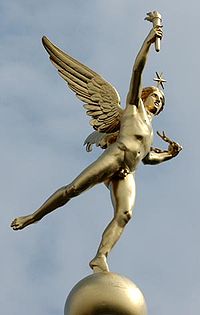July Column
The elephant was completed to designs by Percier and Fontaine in semi-permanent stucco, but the permanent bronze sculpture was never commissioned due to pinched finances in the latter days of the Empire.
The monument, in an elaboration of a Corinthian column, was designed by the architect Jean-Antoine Alavoine, following a commission from Louis-Philippe: the Place de la Bastille was officially selected as the site on 9 March 1831, and the Citizen-King placed a first stone on 28 July 1831, the anniversary of the revolution that brought him to power; a hymn with words by Victor Hugo and music by Ferdinand Hérold was sung at the Panthéon on the occasion.
The Colonne de Juillet is composed of twenty-one cast bronze drums, weighing over 74 tonnes (163,000 lb); it is 47 metres (154 ft) high, containing an interior spiral staircase, and rests on a base of white marble ornamented with bronze bas-reliefs, of which the lion[4] by Antoine-Louis Barye is the most noted.
[6] Perched on one foot in the manner of Giambologna's Mercury, the star-crowned nude brandishes the torch of civilisation and the remains of his broken chains.
Gustave Flaubert, in Sentimental Education, compares the statue to a large golden star shining in the east.
